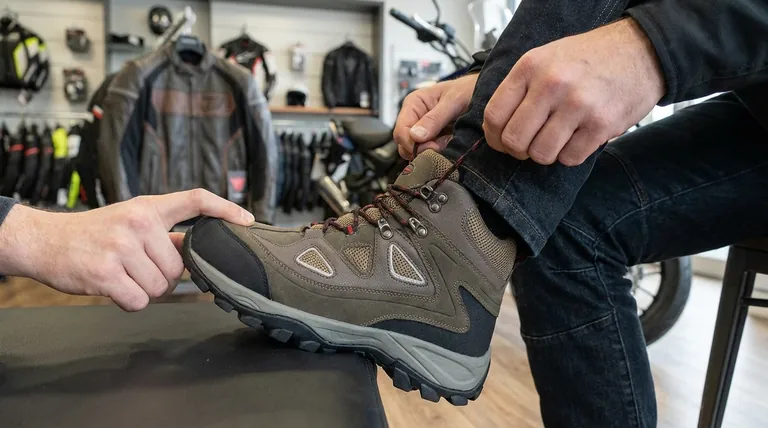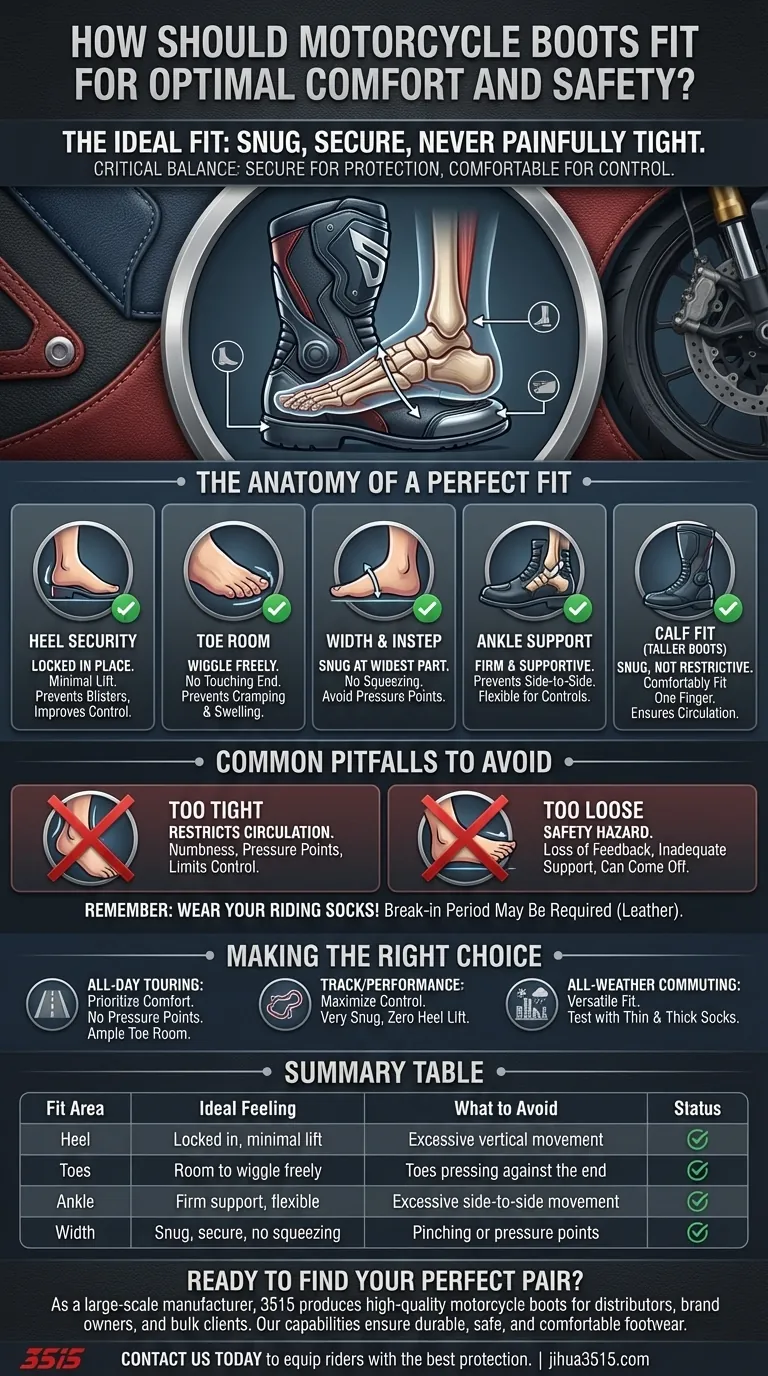The ideal fit for a motorcycle boot is snug and secure, but never painfully tight. Your heel should be locked in place with minimal lift, while your toes have enough room to wiggle freely without touching the end of the boot. The fit must be firm enough to provide support and prevent your foot from sliding, yet comfortable enough to avoid any pinching, numbness, or pressure points.
The core principle of a proper motorcycle boot fit is achieving a critical balance: the boot must be secure enough to act as protective equipment in a crash, yet comfortable enough for long-term wear and precise control of your motorcycle.

The Anatomy of a Perfect Fit
Understanding how a boot should feel on different parts of your foot is the key to making an informed choice. A boot that feels "good enough" in the store can become a significant problem on the road.
Heel Security is Non-Negotiable
Your heel should feel "locked in" to the back of the boot. When you walk, there should be very little to no vertical lift. Excessive heel lift can cause painful blisters and, more importantly, reduces your feeling and control of the bike.
The Importance of Toe Room
You must have enough space to wiggle all your toes without restriction. Your toes should not press against the end of the boot, as your feet can swell slightly during long rides or in warm weather. This space prevents cramping and discomfort.
Width and Instep Pressure
The boot should feel snug across the widest part of your foot. It should hold your foot securely without squeezing it. Pay close attention to any specific pressure points on the top of your instep or along the sides, as these will only worsen over time.
Ankle Support and Flexibility
A motorcycle boot's primary safety function is to protect your ankle. The fit around the ankle should be firm and supportive, preventing excessive side-to-side movement. However, it must still allow for the necessary forward and backward flexibility to operate the gear shifter and rear brake.
Calf Fit for Taller Boots
For boots that extend over the calf, the opening should be snug but not restrictive. You should be able to comfortably fit one finger between the boot and your leg. This ensures it's secure without cutting off circulation.
Common Pitfalls to Avoid
Choosing the wrong fit can compromise both safety and comfort. Two common mistakes are prioritizing one extreme over the other.
The Danger of a "Too Tight" Fit
A boot that is too tight is a serious problem. It can restrict blood circulation, leading to numb or cold feet. It will also create painful pressure points and limit the fine motor control needed for safe riding.
The Risk of a "Too Loose" Fit
Conversely, a boot that is too loose is a safety hazard. Your foot can slide around inside, causing a loss of feedback from the controls. In a crash, a loose boot may not provide adequate support or could even come off entirely.
Forgetting Your Riding Socks
Always try on boots while wearing the specific type of socks you intend to ride with. A thick pair of winter or thermal socks can dramatically alter the fit compared to thin summer socks.
Ignoring the Break-In Period
Many high-quality boots, especially those made of leather, require a break-in period. They may feel stiff initially but will soften and conform to the shape of your foot over time. The fit should be snug and secure from the start, but don't mistake initial stiffness for a poor fit.
Making the Right Choice for Your Ride
Use these guidelines to match the boot's fit to your specific needs.
- If your primary focus is all-day touring: Prioritize comfort by ensuring absolutely no pressure points and ample toe room to account for foot swelling.
- If your primary focus is track or performance riding: Emphasize a very snug, secure fit with zero heel lift to ensure maximum control and feedback from the motorcycle.
- If your primary focus is all-weather commuting: Test the fit with both your thinnest and thickest riding socks to guarantee the boot is versatile and safe in all conditions.
A properly fitted boot is a critical investment in your safety, comfort, and enjoyment of every ride.
Summary Table:
| Fit Area | Ideal Feeling | What to Avoid |
|---|---|---|
| Heel | Locked in with minimal lift | Excessive vertical movement |
| Toes | Room to wiggle freely | Toes pressing against the end |
| Ankle | Firm support, flexible for controls | Excessive side-to-side movement |
| Width | Snug and secure without squeezing | Pinching or pressure points |
Ready to find your perfect pair of motorcycle boots?
As a large-scale manufacturer, 3515 produces a comprehensive range of high-quality motorcycle boots for distributors, brand owners, and bulk clients. Our production capabilities ensure durable, safe, and comfortable footwear designed for optimal fit.
Contact us today to discuss your specific needs and let us help you equip riders with the best possible protection.
Visual Guide

Related Products
- Safety Footwear Wholesale Manufacturer for Custom OEM/ODM Production
- Premium Flame-Retardant Waterproof Safety Boots and Shoes
- High Performance Fire-Retardant Waterproof Safety Boots
- Premium High-Cut Waterproof Safety Boots Manufacturing & Wholesale Solutions
- Heavy-Duty Waterproof Nubuck Safety Boots Safety Shoes for Bulk Supply
People Also Ask
- What are the cultural perspectives on wearing shoes in the house? A Guide to Home Etiquette & Hygiene
- What are OSHA approved shoes? Understanding the Correct Standards for Workplace Safety
- What are the differences between steel toe, composite toe, and alloy toe Wellington boots? Choose the Right Safety Toe for Your Job
- Do snake bite boots work? Your Ultimate Guide to Effective Snake Bite Protection
- Is it normal to wear shoes in the house? A Guide to Hygiene, Comfort & Culture



















